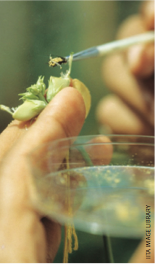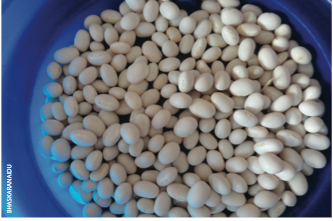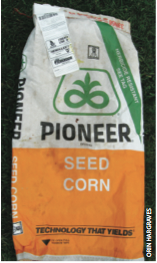SUNDAY, 12 OCTOBER 2014
The human population is predicted to rise to around 9 billion people by 2050. The current global malnutrition estimate has already reached 8-12 per cent with some sub-Saharan regions reaching levels as high as 25 per cent (UNICEF, WHO). This population growth alone will place a major strain on resources, but even conservative predictions of climate change drastically impact arable land productivity. Water availability will become more disparate with arid regions becoming even drier and unsuitable for agriculture, whilst temperate regions will have an increased risk of flooding. Similarly, the yield of many crops is reduced under sustained temperatures above 30 degrees centigrade, a situation that is likely to become common in some regions. The combination of a rising population and a dwindling availability of arable land is worrying in itself, however damage by herbivory is presently also a major problem. If such biotic stress could be combated, less land and water would be required to sustain the global population as yield would be increased. Therefore there is a demand for stress-tolerant crops that are able to cope with low water availability and high temperatures whilst also being resistant to biotic stress. Genetic modification (GM) is one way to create more tolerant crop varieties, but currently these techniques are negatively perceived by the public and thus are strictly regulated. Such broad- scale restriction on GM limits progressive research; here we ask, is this really the safest solution or should each new GM crop be assessed individually for safety in a process-agnostic manner?GM is defined as the intentional modification of the characteristics of an organism by manipulation of its genetic material. Fundamentally, this means that DNA from a donor organism is inserted into the DNA of a recipient organism that confers the ability to produce a protein which the recipient could not previously make. This protein then either goes on to create a useful substance or to carry out a function that the recipient organism could previously not achieve. Research in the late 1980s focused mainly on the possible pharmaceutical applications of such modifications; however the controversy surrounding GM crops really took hold in Europe in 1996 following the arrival of GM soya beans from the US The soya shipments that sparked the controversy were mixtures of several varieties, including up to 2 per cent of a GM variety named ‘Roundup Ready’. The alteration of this soya variety renders it resistant to glyphosate, the active ingredient in a herbicide called ‘Roundup’. This modification resultantly allows farmers to kill weeds using ‘Roundup’ without killing their crops.
Soya is mainly processed to generate vegetable oil, the by-product of which is high-protein animal feed. Member countries of the European Union (EU) are far from self-sufficient in generation of high-protein animal feed and hence around 85 per cent of it is now GM labelled, which is a legal requirement for imported feed if it contains more than 0.9 per cent GM content according to the food standards agency (FSA). Approval for the use of GM soya in food and livestock feed in the UK was gained in 1995 and, less than a year later, an application was submitted to the European Commission and approved. With the green light given for GM soya, companies producing it in the US now sought to branch out to the European market. The approval for this GM crop came amidst significant disagreements between EU member states about labelling of products. As a result of these disagreements legislation regarding the need for rigorous proof of safety and appropriate GM labelling did not come into force until January 1997 with the ‘Novel Food Regulation’. This legislation relates to foods that do not have a significant history of consumption or are generated by methods not previously employed for food. However, the soya arriving in the Autumn of 1996 preceded this regulation and hence was legally sellable without being labelled as a GM crop. It was arguably this mixed shipment of soya that subsequently drastically shifted the public perception of GM in the UK.
During the period of application in the UK there was no official parliamentary debate and only fifteen articles were published in the press. When it emerged GM soya was being shipped mixed in with traditionally- derived crops, several organisations actively tried to prevent shipments from reaching the European market. They claimed that clear labelling of GM crops should be achieved, in line with public opinion, which would not be possible in light of the mixture of GM with traditional varieties in the shipment. Part of the issue arose as a direct result of the fact that perception of risk is more influential than empirical risk. Involuntary risk is perceived by consumers to be more threatening than voluntary risk where labelling is applied, even if the genuine risk is identical. Hence, the lack of clear labelling of these crops as GM is perceived as more threatening regardless of the genuine risk of the product itself. This in turn generated vast amounts of media attention surrounding the issue of GM crops, with their safety and environmental impact being brought into question in over a hundred articles. Public confidence in government regulation on food safety was already damaged by the Bovine Spongiform Encephalopathy (BSE) or ‘mad cow disease’ epidemic and hence greater attention was brought to bear on food standards. Initially, the industry sought to allay fears regarding the safety of ‘Roundup Ready’ soya. Nevertheless, this discord quickly snowballed into concerns about the morality of all biotechnology, with allegations of “playing God” stifling the debate rather than focusing on the product safety itself. At this point the industry changed tack and instead sought to champion GM as the solution to the future problems of food security discussed previously. Unfortunately, the damage was already done and this incident planted a seed of doubt about GM crops within the UK which would grow to become the highly restrictive-policy environment we still have today.
Despite this negative media attention subsequent legislation has permitted the import of various GM crops into the EU including cotton, maize and sugar beet. However, cultivation of GM crops is still strictly regulated in the EU, with only one crop currently approved for cultivation as of July 2014 (maize Mon810, which is modified to kill herbivore pests). On the other hand, several crops have been permitted to be grown commercially in other countries, which have had generally positive impacts. As it stands, over 12 per cent of global arable land is used to cultivate GM crops.
The benefits of GM crops can be exemplified from case studies of GM cotton and maize. These species have both been genetically modified to generate varieties that contain one or more of a group of crystal proteins derived from Bacillus thuringiensis (Bt). These proteins act as natural pesticides and have been used in agriculture for around ninety years via direct spraying either of the protein itself or of spores of the bacterium, which subsequently produce these crystalline proteins that are only toxic to insects. During the 1950s the protein was isolated and, in a move away from synthetic pesticides, the use of Bt proteins became popular amongst farmers. This protein is also permissible for use in organic farming as it is naturally derived and the stipulation for organic crops is the exclusion of ‘synthetic’ pesticides and herbicides. Hence, the GM crops containing this protein have a wealth of data prior to the GM crop generation itself to support the safety of this protein and the only GM crop approved for cultivation in the EU, maize MON810, also carries this protein. In fact the European Food Standards Agency said of Bt-modified maize in 2009 that “...MON810 is as safe as its conventional counterpart with respect to potential effects on human and animal health.”
At present, there is globally more than 50 million hectares of land cultivating Bt-modified crops, including both maize and cotton. In those areas with previously high pest problems, the introduction of Bt crops has drastically reduced insecticide use. In Arizona, Bt cotton was introduced alongside an integrated pest management system that uses knowledge of pest life cycles to improve monitoring of arising problems; particularly focusing on cotton bollworm, the major pest threat. Between 1996 and 2008 this Bt cotton led to a 70 per cent reduction in insecticide use with an estimated total saving of $200 million. However, the use of Bt cotton reduces competition upon other pests that also target this crop and in other introductions this has presented problems. Use in China did lead to increased yield, and initially insecticide use was reduced, but such an integrated pest management system was lacking. This lower insecticide spraying reduced the environmental competition on mirids, an insect that also targets cotton crops, and subsequently insecticide use rose again to only 17 per cent below pre-introduction levels. Nevertheless, this small change still reduced the exposure of farmers to insecticides, and positively impacted upon insect biodiversity, along with increasing yield and farmers’ profit. It is also important to note that growing Bt cotton simultaneously reduces pest outbreaks on neighbouring farms growing non-GM crops, consequently raising the yield of surrounding farms. Hence, we see that with effective pest management, GM crop introductions can provide large benefits to the farmer and their environment.
Yet the introductions of Bt cotton highlights the need to critically assess all impacts of any novel crop introduced to market; environmental, economic and societal impacts of GM must all be taken into account before the crop is cultivated. The employment of a more rigorous integrated pest management programme in China would likely have led to similar benefits to those observed in Arizona. However, the lack of continued management eventually led to reduced benefits and a dissatisfaction of farmers with the product. Therefore, a GM crop introduction must also be sensitive to the particular ecosystem in which it is to be introduced, but, more importantly, to existing agricultural practices.
Much of the focus on GM crops surrounds the idea that they are innately harmful, with traditionally-bred crops being perceived as completely safe. However, traditional breeding is not without its pitfalls. In the late 1960s, breeders sought to create a potato with a high starch content so that it was better for making crisps, resulting in the ‘Lenape’ variety. The variety was initially approved for cultivation by the US but this approval was withdrawn seven years later. To achieve high starch the traditional breeding method had also inadvertently more than quadrupled the production of a natural toxin called Solanine (from 8 to 35mg/100g). This is the same toxin produced when potatoes turn green and leads to severe nausea, diarrhoea and even unconsciousness in extreme cases. In another more recent case, severe skin rashes were observed in Southern Israel on the hands of farm workers who had been harvesting traditionally bred celery. It transpired that the variety had twice the concentration of toxins called psoralens than other varieties, and this had induced the rashes. In light of these incidents, perhaps it is counter intuitive that extensive, rigorous testing and control is not applied to all crop products, regardless of whether or not their origin is from GM or ‘traditional’ breeding. At present, the differences in the process used to generate crop varieties are precisely where the distinction resides.
Crop varieties may be produced by traditional breeding practices in which farmers select favourable characteristics of varieties over several generations. This process can take a large number of generations to acquire the beneficial traits of both original parents and can result in carry-over of undesirable genes in the process, as described in the examples above. Once grown, this new variety undergoes some minimal testing to ensure it consistently provides the proclaimed benefits, but its safety is generally considered to be equivalent to that of the original parent plants.
In contrast, the commonest method for genetic modification of plants is transformation using a species of bacteria called Agrobacterium tumefaciens. In nature, A. tumefaciens is responsible for causing crown gall disease; by inserting sections of bacterial DNA (known as T-DNA) into the host plant’s genome, inducing massive growth and proliferation of the plant’s cells. During the infection, the bacterium absorbs sugars synthesised by the host plant. Inside the lab, this special ability to transfer DNA across taxonomical domains allows modified bacterial T-DNA to carry a particular gene of interest, for example the Bt gene discussed previously, which is then inserted into the plant genome. The A. tumefaciens is therefore a vessel that facilitates
the transfer of genetic material into a plant which produces a new variety relatively quickly and with no unintended gene carry-over. However, once any novel GM crop has been created, an exceptionally rigorous and strategic assessment needs to be made of the benefit it incurs and the safety of the new variety, both of which are significantly more stringent than those for the traditionally-bred varieties.
The steps taken will depend on the use of the GM crop; for example if the crop will not encounter the human food chain it will not have to be tested for food safety. Most importantly, proof of an added benefit over the conventional crop is needed. To this end, extensive field trials are usually required to provide enough statistically-significant evidence that the GM technology has a reproducible benefit over other varieties. Along with the final legal registration of the GM crop within the EU, field trials present one of the largest costs to the commercialisation process of a GM technology. Food and feed safety assessments are usually done using laboratory techniques. Most transgenic plants contain a novel protein, and this introduced protein is targeted in safety checks. Acute oral toxicity studies are conducted, usually using mice, to check for an allergenic or toxicity risk for animals and humans, as well as longer-term feeding experiments to check the growth characteristics of animals being fed the GM crop. Resultantly, the costs involved in getting a crop to market through all of these safety checks is prohibitively expensive for all but big agricultural companies. This perpetually stifles innovation in the field because it prevents smaller firms from developing new crop varieties.
Currently many governments struggle to keep pace with the rapid evolution in the field of GM research. Policy-makers are elected by the public, which is reflected in the science-policy legislation that they produce. Communication between members of parliament and the public goes both ways however; not only should science policy be based on public opinion, but policy should also have the opportunity to shape the very opinions that impact it so highly. Rather than GM policy being singly reactive to both technologies and public opinion, policy makers should strive to set an example for the future that they hope to achieve. For example, GM and GM-free labelling supports the view that transgenic and natural crops are different entities and should be treated so. At present, we have a negative labelling system in which the absence of GM constituents or processes is indicated (amongst other things) through using the ‘Organic’ label, which is in contrast to a positive labelling system in which products would be specifically labelled as ‘GM’. Although there may be arguments for labelling of GM foodstuffs, the impact this labelling and differentiation has on public opinion should also be taken into account.
Unfortunately negative opinions of GM crops and the actions of environmental and consumer groups, have contributed to creating a ‘wicked problem’ for the introduction of GM crop technology in many countries. This ‘wicked problem’ being that the expense and delay created by policy towards new GM technologies not only means that these regions are unable to benefit from the advantages of GM crops, but it also holds back technological advances. This is especially true for small biotech start-ups, which drive many of the advances in other fields, such as cancer research or drug delivery. The main deterrent to the spread of GM crops and to GM biotechnology is consequently the policy choices made worldwide rather than their empirical safety.
Opponents to GM crops generally focus on food safety, driven by the persistent perception that these foods are ‘unnatural’ and therefore dangerous. This goes back to the earliest controversy in 1996 in which the perceived dangers of GM soya first arose. Some recent studies have found correlations between cancer and GM crop intake–though these were initially retracted they have since been republished. Predictably these studies have made a huge impact on public opinion, despite their general renouncement by the scientific community for their poor experimental design and lack of appropriate statistical analyses. Conversely, there is a plethora of evidence from long-term ingestion studies, and the actual human consumption of GM crop products since 1996, showing that the food safety risks posed by GM crops are no higher than those posed by non-GM equivalents, yet this seems to have failed to reach the public sphere of consciousness. The problem therefore lies in how to improve the public understanding of the introduction of GM crops in light of the existing perceptions of their risk that leads to broad public rejection of all introductions, in turn restricting policy decisions.
The most important question is whether to treat GM crops any differently from any other crops. Currently non-GM crops are also highly regulated, and if GM crops are assumed to be the same, they should undergo the same treatment. The American Association for
the Advancement of Science, in keeping with the general scientific consensus, stated in 2012 that “foods containing ingredients from GM crops pose no greater risk than the same foods made from crops modified by conventional plant breeding”. Hence one would expect GM crops to undergo the same treatment as other non-GM crops. In some countries, such as the US, the truth is close to this expectation. As usual however, novel technology brings novel suspicion, especially if it is not fully understood by the general public, and so the unknown or unpredicted dangers of GM crops dictate the policy decisions in most countries. For policy to address the existing GM crop fears adequately, it may be beneficial to separate out the different sectors in which GM policy can act. This can be segregated into intellectual property rights, biosafety, trade, food safety and consumer choice, and public research investment. Once the different areas are defined, then policy makers in different countries can decide which avenues to take with each to maximise benefits to their own country’s requirements–whether they are promotional, permissive, precautionary or preventative. Ultimately any policy decisions essentially determine how difficult and expensive it is to bring a GM crop to market globally.
The policy climate in Europe is probably the worst in the world, with very strict GM regulations. To overcome the long-standing policy deadlock in the EU, a safeguard clause in legislation was included in 2001 that allows Member States to restrict or prohibit the use and/or sale of GM organisms in their territory (Article 23, Directive 2001/18/EC). Since this clause has been included, eight countries have already banned the cultivation of maize MON810 discussed previously, further allowing member states to impose even more prohibitive GM policy choices. Under co-existence regulations, they may also designate GM-free zones, effectively allowing them to ban GM crops without even invoking this safeguard clause. Consequently, these disagreements over policy between European member states lead to a highly fractured legal framework at the EU level.
Sir David Baulcombe, the UK Regius Professor of Botany, believes that “Food and agriculture are too important to be held up behind a red flag. We need minds that are open to new technology in agriculture and an end to the Punch and Judy of GM. It’s time
to start talking seriously about a new way forward for crops and how we grow them”. Unfortunately current EU policy means that many member states are folding under social pressure, which also negatively impacts upon broader EU policy. The limitations imposed, and resultant costs of commercialisation, prevent development by small biotechnology companies, leaving GM crop production to be the reserve of big business. This stifles progress in the field because it reduces global commitment to the development of this technology. The restrictive legislation similarly further compounds negative public perception by reaffirming continued concerns over societal, environmental and health impacts as it exhibits legislative reservation in the acceptance of these crops.
GM crop policy should be sensitive to the environment, both natural and figurative, into which this emerging technology is going to be introduced. To that end, the policy decisions made by a country should take into account its own agricultural challenges, economic aims, research capacity, and public opinion. Developing countries, who likely face a stronger imperative to alleviate agricultural challenges whilst also having a lower research and regulatory capacity, should not be seeking to fit to either the
US ‘promotional’ model or the EU ‘restrictive’ policy models. Instead, for each sector of GM crop regulation, countries should be carefully deciding where along this spectrum they lie in order to set up their countries to be able to safely benefit from the advances being made by scientists. More importantly, similar to each sector of GM crop policy being treated separately, each GM product should be treated as a singular case. Rather than “Yes to GM” and “No to GM” we should look at each case individually
for the safety and benefits that the final product provides. Rather than judging the method by which something is produced, we should have the choice between “Yes to THAT variety” and “No to THIS variety.” Hence, rather than ‘process focused’ policy that currently prevails, we should be moving towards ‘process agnostic’ regulation. As global GM policy is brought up to the same rigor as the scientific testing it demands, public opinion may begin to change.
Emily Bailes is a 2nd year PhD student in the Department of Plant Sciences.
Daisy Hessenberger is a 4th year PhD student in the Department of Plant Sciences.
Greg Mellers is a 2nd year PhD student in the Department of Plant Sciences.
Nathan Smith is a 3rd year undergraduate in the Department of Plant Sciences.







